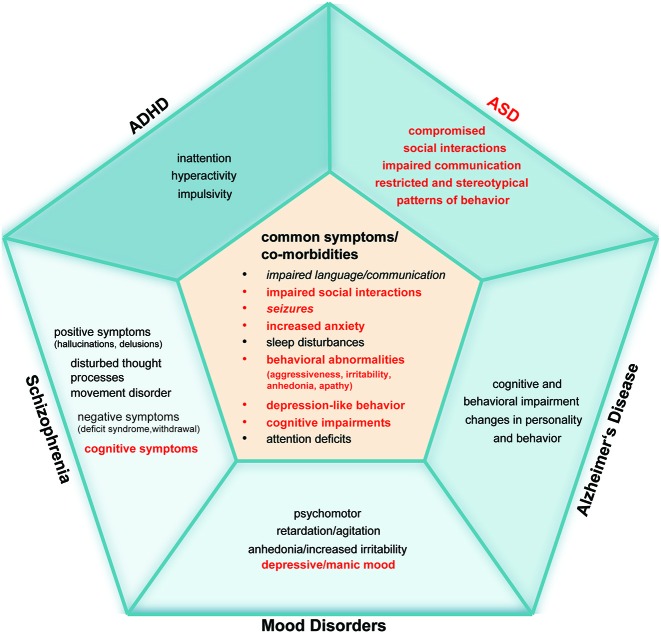Figure 2.
Comparative overview of alterations reported in specific human diseases that share a behavioral pathology possibly associated with zinc deficiency. Zinc deficiency is commonly reported in ASD, ADHD, Alzheimer’s Disease (AD), Schizophrenia (SCZ), and Mood Disorders (MD). Symptoms and comorbidities labeled in red are known to be associated with zinc deficiency. The inner pentagon summarizes symptoms and co-morbidities that co-occur in ASD, ADHD, AD, SCZ and MD (symptoms and co-morbidities that are written in italic do not appear in all five disorders: language and communication problems have not been reported to occur in MD. ADHD or MD patients do not suffer from seizures more frequently compared to healthy controls). “Impaired language and communication” includes impaired language functions, absence, delayed or reduced speech, speech problems and talking in a dull or monotonous way. Unstable relationships, difficult peer relations, the loss of empathy, social withdrawal and the reduced interest in social interactions are summarized by “impaired social interactions”. “Increased anxiety” implies panic disorder, posttraumatic stress disorder (PTSD), obsessive or compulsive disorder, and anxiety disorder. “Sleep disturbances” include trouble sleeping, daytime sleepiness such as longer “sleep onset latency,” frequent night-time awakenings and reduced sleep duration. Irritability, agitation, apathy, aggression, anhedonia, and self-injurious behavior are summarized by “behavioral abnormalities”. “Depression-like” behavior combines depressive mood, impaired motivation and initiative, loss of drive, decreased interest in previous activities, and feelings of hopelessness and helplessness. “Cognitive impairments” summarize thought disorder, lack of ability to begin or sustain planned activities, impaired executive functions (ability to understand information and use them to make decisions), problems with working memory, learning disability, impaired reasoning and handling of complex tasks, learning and memory deficits. “Attention deficits” implies inattention, trouble concentrating or making decisions and diminished concentration. The outer pentagons contain the core features of each disorder that are important for diagnosing the disorder. It is visible that the mentioned disorders share similarities, in particular in co-morbidities that frequently occur in these disorders, that are associated with zinc deficiency. Further research is needed to investigate, whether these co-morbidities are caused or modified by zinc deficiency.

